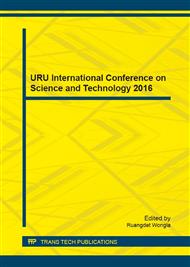[1]
T. Chanyatham and S. Kirtsaeng, Comparison and Analysis of Remote Sensing-Based and Ground-Based Precipitation Data over India. Chiang Mai Journal of Science, 2011, 38(4): 541-550.
Google Scholar
[2]
S. Kirtsaeng and P. Sukthawee, Comparison of rainfall pattern and statistical verification of CPS for extreme rainfall simulation on 13 April 2013. International Conference on Science and Technology, 2015, 481-488. (DOI : 10. 1109/TICST. 2015. 7369403).
DOI: 10.1109/ticst.2015.7369403
Google Scholar
[3]
P. Chantraket, S. Kirtsaeng, C. Detyothin, A. Nakburee and K. Mongkala, Characteristics of Hailstorm over Northern Thailand during Summer Season. Environment Asia, 2015, 8(1): 101-114.
Google Scholar
[4]
J.W. Wilson and E.A. Brandes, Radar Measurement of Rainfall - A Summary. Bulletin of the American Meteorological Society Journal, 1979, 60(9): 1048-1058.
DOI: 10.1175/1520-0477(1979)060<1048:rmors>2.0.co;2
Google Scholar
[5]
J.G. Ciach and W.F. Krajewski, On the estimation of radar rainfall error variance. Advances in Water Resources, 1999, 22: 585-595.
DOI: 10.1016/s0309-1708(98)00043-8
Google Scholar
[6]
P.W. Li, W.K. Wong, P. Cheung and H.Y. Yeung. An overview of nowcasting development, applications, and services in the Hong Kong Observatory. Journal of Meteorological Research, 2013, 28(5): 859-876.
DOI: 10.1007/s13351-014-4048-9
Google Scholar
[7]
J.S. Marshall and W.K. Palmer, The distribution of raindrops with size. Journal of Meteorology, 1948, 5: 165-166.
Google Scholar
[8]
D. Rosenfeld and E. Amitai, Comparison of WPMM versus regression for evaluating Z-R relation. Journal of Applied Meteorology, 1998, 37: 1241-1249.
DOI: 10.1175/1520-0450(1998)037<1241:cowvrf>2.0.co;2
Google Scholar
[9]
R.A. Fulton, J.P. Breidenbach, D. Seo, D.A. Miller and T. O'Bannon, The WSR-88D Rainfall Algorithm. Weather Forecasting, 1998, 13: 377–395.
DOI: 10.1175/1520-0434(1998)013<0377:twra>2.0.co;2
Google Scholar
[10]
P. Chantraket, P. Intaracharoen and S. Kirtsaeng, Analysis of Rainstorm Characteristics in Eastern Regions of Thailand. International Journal of Applied Sciences and Innovation, 2016, Vol. 1: 58-70.
Google Scholar
[11]
M.L. Shelton, Hydroclimatology: perspectives and applications. Cambridge University, (2009).
Google Scholar
[12]
P. Chantraket, C. Detyothin, S. Pankaew and S. Boonpring, Radar rainfall estimation over the central of Thailand. Department of Royal Rain Making and Agricultural Aviation, (2013).
Google Scholar
[13]
R. Hanchoowong, U. Weesakul and S. Chumchean, Bias Correction of radar estimates based on geostatistical technique. Science Asia, 2012, 38(4): 373-385.
DOI: 10.2306/scienceasia1513-1874.2012.38.373
Google Scholar


